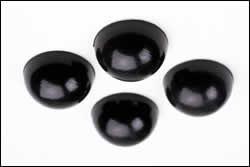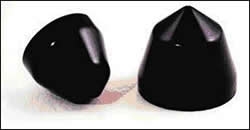Product: Blobs & Cones
Manufactured by: Isonodes - USA
and: Polychrystal - USA
Approx. cost: 19.99$ USD (set of 4 IsoNodes)
Reviewer: Mark Wheeler - TNT UK
Reviewed: September, 2004
Part 1 was my monologue on WHY YOU NEED TO PROTECT YOUR AUDIO COMPONENTS FROM VIBRATION and part 2 described the effects I observed on particular turntables. In them I noted the lack of interest I'd had from UK manufacturers & distributors of Clearlight (RDC) and Spectra Dynamics (Polipods & Foculpods) and they still haven't bothered to get back to me so I guess they don't want your business.
This is in complete contrast with our American cousins at Bright Star
(Isonodes) & UltraSystems (Polychrystal) who were both very helpful.
Barry Kohan (Isonodes) was keen to respond to my comments on the unsuccesssful
effects of the Isonodes on the Thorens TD160S & Mitchell Gyro SE in Part 2. Barry was so surprised by my findings
that I retested the original setup and tried some variations but the results
remain the same. Both turntables have suspended subchassis tuned below 10Hz and
my hypothesis is that the suspension compliance (including the belt tension) is
reacting destructively with the Isonode compliance, possibly resulting in
simple-harmonic-motion at an unobserved micro-level. This may have caused the
loss of pitch and rhythm that I described.
Rigid plinth turntables, e.g. Rega
models, are less likely to be detrimentally affected. You must try out examples
of each type under your own turntable to find out which works best.
Neuropsychologists & psychiatrists are currently researching suggestibility & its relation to later onset of psychosis. One of the tests comprises a period of white noise to which the subject is exposed after being asked to identify whether an excerpt of Bing Crosby singing "White Christmas" is embedded at the start of the burst or near the end. Such a high proportion of the population make an identification that the test is inadequate for its intended purpose. There is no excerpt of "White Christmas" embedded behind the white noise. The suggestion that there might be causes listeners to imagine that it is there, whether they are prone to psychosis or not. I have taken this test (recently broadcast on BBC Radio4) & readers will be pleased to know I failed to hear any Bing Crosby on both occasions. This suggests that I am an unimaginative dullard not prone to audio flights of fancy.
So when I write that I have heard very clear repeatable differences between little gizmos less than 4cm accross I do hope readers will not assume I am deluded or prone to aural hallucinations.
![[Rotel 965 BX inside view]](../jpeg/rotel965bx.jpg)
A second listener, Heather, who refuses to accept that "bits of wire" can & do sound different, participated in these tests. Heather was unimpressed with concepts like soundstage & neutrality & P.R.a.T., but introduced her own parameter of "fuzziness". "Fuzziness" is a bad thing and describes beautifully all the ideas of raised noise-floor & imprecision that we attribute to vibrational effects on electronic audio gear. Heather's hearing, although exposed to years of close-proximity abuse from the p.a. systems of the likes of The Ramones and Iggy Pop does not suffer the deterioration of 45year-old male that my hearing might suffer.
The CD player chosen was my old Rotel RCD965BX Discete. It's the perfect candidate for this test as electronically it is superb but mechanically appalling. The "BX" designation indicated higher spec components & psu incorporated into the original manufactured product. The "Discete" appellation denotes the replacement of the output op-amp chips with a piggy-back board carrying a class-A circuit of discrete transistors. It took me a long time to find a CD player I could tolerate enough to buy and this was the first since CD was announced. Interestingly I later noticed in a test of reclocking modifications that this Rotel had the lowest jitter of all 6 players tested & was the only one that did not benefit substantially from the mods under test. The interior of this player is populated with good quality polypropylene, other-film & silver-mica capacitors & no less than 22 Black Gate type F capacitors, metal-film resistors (unmarked but possibly Roederstein), with derated diodes & regulators mounted on a double-sided copper ground-plane main board and the Discete board is marked "designed and built by ROTEL UK".
This splendid recipe then gets thrown unceremoniously into a clangy steel box with no attempt at structural integrity or resonance damping. Perfect for our test. The 4 standard feet are plastic discs with rubber inserts. Between each test sample this stock configuration was to be heard and our ears recalibrated to the zero position on each parameter.

The listening panel began to tire of the repeated unmodified condition,
as William Blake's illustration shows
Each parameter could be judged on a range -3,-2,-1,0,+1,+2,+3 compared to the standard configuration. 0 represents no clear discernable difference, 1 represents the smallest discernable difference, 2 represents a very clear difference, 3 notes a REALLY BIG difference. There are 20 parameters so a barely noticable improvement in all areas would score 20 as would big improvements in a third of them.
First up were cheap cork pads (from Wilkinson stores) added below the original feet. Many areas improved +1, although Heather & I differed about the new "Fuzziness" parameter, which I believed improved but she didn't. Excellent value at less than 2 € and scored an improvement figure of 5. Similarly a stack of the cork/rubber spacers used to pack glass sheets during transit were also tried to lift the standard feet off the shelf and the score became 6.
Next under the CD player were the Solid Polychrystal Isolators ($65 for a set of 3) that triumphed in the turntable test. These scored better than the cork pads. Bass was tighter & more tuneful, the soundstage broadenned & treble seemd more extended & tuneful. It was as if the bandwidth of the player was wider, which seems theoretically impossible under the circumstances. The dynamic range was greater, which is much more likely with a lowered noisefloor but also less compressed at high amplitudes. Fortissimo much more fortissimo that the mezzo-forte maximum imposed by the standard player. At this stage I was asking myself "Why would a manufacturer of any player above €400 fit cheap feet when something better can make so much difference?". Numerically they scored 8 but this modest number does not reflect the obvious difference. Robert Stein of Ultra Systems notes that Polychrystal sounds better under "better sounding materials like wood" so this will be tried later.
The final product under the cd player in its standard configuration were the Isonodes. These are the largest sized ones designed to hold up to 19kg per set of 4. Unfortunately 3 Isonodes deformed so much under the pathetic 4.5kg mass of the Rotel that its nasty plastic feet remained in contact with the shelf. I tried 2 configurations at this stage.
1 – An Isonode under each original plastic foot
2 – Seven Isonodes distributed unevenly directly under the player chassis
Both of these configurations were better than anything that had gone before. The second, with the Isonodes in direct contact with the chassis floor was slightly superior to the first but the Isonodes were now individually supporting too little mass to perform at their best so the Rotel's original nasty plastic feet had to be removed.
At this point I realised that this represented a second variable in the equation so I retested the Polychrystal cones and confirmed my earlier findings were identical in the new footless styly scoring a slight increase to 11.
Three points of support are the minimum for anything so 3 Isonodes were placed under the player (they should be stuck with the attached self-adhesive pads, but this would entail a once-only use preventing comparisons. This was the best sound so far. Even sceptical Heather rated them really highly, noting that she was surprised at how cleanly & clearly the triangle & temple-bells could be heard on the Chesky Sara K album "Closer Than They Appear"(Chesky JD67). Heather rated the fuzziness improvement at 3. The noise floor seemed lower than the Polychrystal cones but overall dynamic range similar. Midrange was clearer, sweeteer & more natural than the preceding tests. Qualities of pace, rhythm & timing were slightly different from the Polychrystal but it was hard to decide which was more accurate or more enjoyable and similar ambivalence applied to bass. In every other parameter the cliche of a veil lifted deeply understates the reaction of the listening panel, as William Blake's illustration shows as the score leapt to 31 in this condition.

The veil of Vala, composed of the Spectres of the Dead, is lifted
Hoping to get the best of all possible worlds I then inserted various combinations of 1 or 2 Polychrystal cones & 1 or 2 Isonodes in different arrangements beneath the player. Sadly the result was merely somewhere less than either of the two characters scoring just 10.
Then I tried a different shelf material than the 12mm laminated glass used so far. This was a home-made laminate construction with a central core of ultralight insulation board. This was the first change that made any difference to the pace-rhythm-and-timing (P.R.a.T.) trio of parameters, adding just 1 (barely discernable difference) using the shelf's inbuilt spikes. It scored a total of 18. As soon as any of the other treatments were tried with this shelf the improvements became identical to their performance on the glass shelf and the P.R.a.T. gains disappeared.
So now it seemed like a good time to try these products between the glass-shelf & and the Target wall-frame. In standard trim the shelf should sit on 4 adjustable spikes, but long experience has taught me that 3 spikes are always equal or better so the front-right spike was removed (the cd player centre of gravity is toward the back-left so this spike would have least load). Each product was tried first with the same between shelf & frame as between shelf & player. The cork pads improved slightly, the Polychrystal improved even more (now scoring 15) but curiously the Isonodes (4 needed under shelf) were not quite as secure sounding as the single set above although the scores remained the same. Combinations were tried and the outright winner with the unmodified cd player were 3 Polychrystal cones under the shelf and 3 Isonodes between the shelf & player, scoring a heady 35.
You never know what is enough unless you know what is more than enough William Blake Proverbs of Hell quoted by Jah Wobble
The next experiment was to put the lightweight laminated shelf under the player direct on the Target shelf's own spikes, 3 Isonodes on the shelf and the player on them. On top of the player were placed 3 more Isonodes and the heavy 12mm laminated glass shelf on top of these. No other top loading combination could be tried because of height clearance problems with the turnatble shelf above. This maxed the vocal scores to 3+3 & improved macro & micro-dynamics bringing a total score of 35.
Realising how much this demonstrated the cd was being hampered by its steel case, I removed it. OK, I confess, I have done this before, the cd player normally lives in a RATA Torlyte case that is no longer available and was bought many years ago from Russ Andrews in their final stock clearance of these items, when I bought all that were available. With no other support product (it has 3 built-in spikes) it was the equal of the Isonodes in every area and bettered them in several. P.R.a.T. parameters all gained, transients & inter-transient silence both scored 3. Voices maxed 3+3, treble clarity, sweetness & tunefulness 3+3+3. Microdynamics 3, macrodynamics 3, fuzziness 3. Across 20 parameters the replacement case scored 42 points of improvement over the standard product.
At this point readers are thinking that if they don't want to open up their cd player the best option is Isonode feet beneath cd player & shelf. A further gain may be made with 3 Polychrystal cones between the shelf and its support and in my view these two options represent excellent value for money. Indeed I cannot understand why so many manufacturers put their product in such trashy cases and support them with such poor feet after they have spent so much money on great internal engineering. The KI Ken Ishiwata series Marantz cd players do address this situation with heavy copper & copper plated chassis components and such a large & successful company are unlikely to waste product-cost resources.
Now this review is faced with a problem. The high scores reached by the new case do not leave room for improvement at all in 9 of the parameters and very little room for improvement in 3 more. It is time to recalibrate my ears and listen to this set-up until it is familiar enough to reset zero across all parameters.
While trundling through the cd requests of my children we played Jah Wobble's The Inspiration of William Blake (30Hertz & All Saints Records ASCD29). While generally being a very processed recording, recorded & mixed in various locations with differing personnel, there are moments when JW's voice has a BBC type natural realism that reached new standards during this review. Jah Wobble's crossover bass style (he was bassist in Public Image Limited) also benefited in tunefulnes & clarity.
Differing acoustic effects seemed to emerge, especially around percussion, from track to track on the Jah Wobble cd. This seemed odd as the sleeve notes imply just 2 recording venues although many different personnel in playing & production. Much music later with my ears recalibrated to this new level of performace and the whole scoresheet zero-calibrated again, the test restarted in earnest.
My hypothesis was that the better casework would reduce the differences between each product, possibly removing any difference at all. The earlier tests had shown that these products were sufficiently good isolators to reduce the effect of the shelf material to irrelevence. So the cork cork pads were inserted and surprisingly made a similar amount of difference. However, this time very different results were obtained with different music. Vocals drew attention to this ambivalence, high range female vocals scoring +1 for embodiment and 0 for neutrality, while male vocals scored -1 for embodiment and 0 for neutrality.
Next the Polychrystal cones were tried and made much more difference under the modified player than under the original. 14 points were now scored with evenly spread small improvements. The Isonodes were tried and scored 12, excelling once again with vocals & treble. This was now very close so they were alternated with various selections, long & short. My complicated switching procedure using cutlery & surgical-forceps became very practised. Adding extra mass made no difference to the Polychrystal Isolators but did bring the Isonodes up to 14. Sadly there wasn't sufficient clearance to try Isonodes & Polychrystal either side of the shelf.
Conclusion
If you are safety knowledgable you could remove the steel case from your cd player and replace it with something that does not suffer the magnetic hysteris & vibrational problems of steel cases and this is the biggest improvement you can make. Additionally you should install either 3 Isonodes or 3 Polychrystal Isolators between the player & shelf. Extra mass on top of the player will increase the effect of the Isonodes, but do not exceed the maximum recommended for whichever size of Isonode. Do not replace the player-case unless you are fully conversant with safety implications & confident that you have not compromised the safety earth (ground). This raised the player performance an order of magnitude and similar gains would be available with any low-resonance wooden sleeve replacing any clangy steel case.
If you keep the standard case the biggest improvement will be inserting 3 Isonodes between it and the shelf. The effect is even greater if an additional mass is placed on top of the player, again supported by 3 Isonodes placed as described. These should be placed to maximise the damping effect on the unsupported area of steel, not around the more rigid edges. A further improvement will be the installation of 3 Polychrystal cones betwen the shelf & its support. This combination is so good that it renders choice of shelf material almost inaudible.

The Bright*Star Audio Isonodes do the best job of ameliorating the problems of structure born vibration and of acoustically-induced resonant vibration in the player. They also make a whole range of much more advanced products, beginning with the IsoRock and progressing through various ranges, some tailored to specific products (VPI turntables, Cary & Jadis amplifiers etc.).
As UltraSystems state, the Polychrystal Isolators only give of their best with matching shelf materials, and this test idicates that this applies to the structure of the hardware component being supported. My own experience here indicates that they are better described as optimisers than Isolators and that they "will not turn a sow's ear into a silk purse".

In my system with the optimised casework & laminated-glass shelf the Polychrystal cones majored on dynamics (meta & micro) while the Isonodes excelled in treble (purity & clarity). Both had a beneficial effect on midrange, especially vocals and also improved inter-transient silences.
With a standard steel case player I would strongly recommend the Isonode
Anti-Vibration feet plus the Polychrystal Isolators. With an optimised
player you MUST try both and decide which works best in your system.
Both these products are so good that you'll find another home for the ones you don't use
under your cd. Although you can make a surprising difference with cheap
solutions like cork-pads I have been pleasantly surprised by the cost-effectiveness of these speciality products compared with components & cables.
[Rewind to Part I] - [Rewind to Part II] - [Fast forward to Part IV]
© Copyright 2004 Mark Wheeler - www.tnt-audio.com